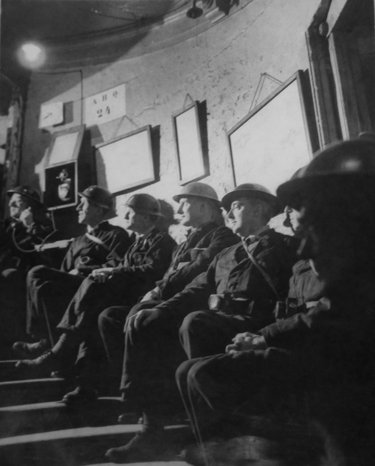
Members of the St. Paul’s Watch at one of the advance locations around the Cathedral.
During the German Blitz, civilian volunteers, many in old age, risked their lives to protect London’s St. Paul’s Cathedral from bombs and fire. One such volunteer who served in the St. Paul’s Watch left a diary (alas! long out-of-print, expensive, and scarce).
link
Arthur Butler was a melancholic, artistic man, a retired architect known for his slightly rambling way of speaking. On the night of April 16, 1941, when a bomb fell through the roof of St. Paul’s, London, he was high on the cathedral’s dome, wearing a flashlight on a belt around his waist, looking at the fires reflected in the Thames, far below. Butler liked the shadows on nights like these, cast from strange angles by falling flares. He had enjoyed the bursts of artillery in the previous war too, flashing orange over the trenches, when he was young. Now, flames crept into crimson smoke, as buildings burned white, then red, then orange. Many were skeletal, from earlier raids. It was a “weird and terrible loveliness,†Butler recalled. As planes flew closer – “silly screaming dragons,†he wrote – there was a crescendo of anti-aircraft fire. Memories overcame him. Fire engine bells rang in the distance.
Isolated amongst ruins, the German planes seemed to seek out St. Paul’s. It was, according to Butler, “the very heart of London and the symbol of it,†apparently defiant and certain. In his long out-of-print diary, which was published in 1942 as Recording Ruin, he called it a “sacred place as a race.†(I recently found a copy in a secondhand store and thought it looked interesting.) A church had stood here since the year 604, and cathedrals had been built, and destroyed by fire, ever since. The present St. Paul’s was begun in 1675, and it was still the city’s tallest building. During the war, it took on huge psychological significance. At the end of 1940, two weeks before Butler began writing his diary, the Daily Mail printed what would become the most famous photograph of the Blitz, with the dome rising from smoke, beneath the headline: “War’s Greatest Picture: St. Paul’s Stands Unharmed.†(The same photograph was reprinted in German newspapers, to suggest London’s destruction.) During the worst raids, Winston Churchill himself ordered fire fighters to protect St. Paul’s, passing needier buildings.
Inside the cathedral that April night, as Butler watched the buildings burn, a single red light hung from the underside of the dome. Water sometimes pooled beneath it, blown in through shattered windows. The high altar lay ruined, destroyed in the raid featured in the Daily Mail’s “unharmed†photograph, a tangle of scaffold supporting the arch above. The little remaining stained glass glowed from the fires outside, picking out a mechanism of pulleys and gantries, designed to lower the injured from the upper floors. Butler liked the cathedral most this way, icy blue and painterly in the moonlight, the white stone whiter somehow, the shadows rich and dark, with just a hint of red. Dim flashlights could be seen scurrying around the Whispering Gallery, and down the mile or so of cathedral corridors. A dozen men, mostly middle-aged or elderly, carried sandbags and water pumps, hurrying to the incendiaries that rattled on the lead roofs, like coals falling from a scuttle. Water ran down the staircases hidden in the hollow walls, as women carried up cups of tea.
Each night, a shift of these volunteers, known as St. Paul’s Watch, guarded the cathedral. Many, like Butler, had been architects, and had fought in World War I. Shortly before the Blitz began, the Dean of St. Paul’s advertised for help, hoping former architects might familiarize themselves most easily with the cathedral’s labyrinthine plans, and perhaps cared enough to risk their lives for it. Two hundred and eighty people put their names forward. They were issued overalls and tin hats, and given training on explosive incendiaries, delayed action bombs and parachute mines. They walked through tear gas, to prepare for what might come.
Alongside the architects, there were minor canons and elderly gentlemen of the Choir, Red Cross workers, and members of the Women’s Royal Voluntary Service. There were university professors, and students of medicine and theology and music. John Betjeman, the future Poet Laureate, volunteered, with Post Office workers, and members of foreign governments in exile. “A cross-section of English society,†the Dean wrote in his account of the war, “essential, yet unobtrusive, vital but anonymous.†Some would find their evenings empty after the war, with nothing to do, feeling old again.
Before their shift began, those on duty prayed the same prayer at the Watch headquarters in the cathedral Crypt – “lighten our darkness, we beseech thee, O Lord; and by thy great mercy defend us from all perils and dangers of this night†– and listened to the news on the wireless. Many felt the hand of God protected them. One volunteer routinely circled the exterior of the dome, reciting the Lord’s Prayer. Each wore a gold pin on their left breast, decorated with crossed swords. A friend of Butler’s had once laughed at his badge, when he wore it to a dinner party. “I suppose it’s the same as displaying emotion and is therefore not done,†he recalled.
The story of the St. Paul’s Watch.

This tablet remembering The Watch is set in the floor by the western end of the Cathedral





Please Leave a Comment!